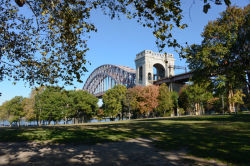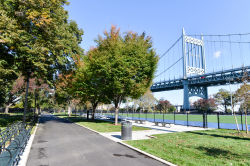Astoria Park
Long Island War Memorial
The architectural firm of Ruehl and Warren designed this classical memorial in Astoria Park. The monument consists of a 20-foot wide and 10-foot high base of granite quarried in Concord, Massachusetts. Into this pedestal is inscribed a dedicatory message to those Long Island residents who gave their lives in defense of their country in World War I.
World War I (1914-1918) began after the assassination of Archduke Francis Ferdinand in Sarajevo on June 28, 1914. War ensued, pitting France, Great Britain, and Russia against Germany, Austria-Hungary, and the Ottoman Empire. The United States initially declared its neutrality, but this changed when Germany announced in February 1917 that it would no longer respect the neutrality of the seas, instructing U-boat commanders to attack any Allied vessel. President Woodrow Wilson (1856-1924) protested this action and within three weeks the U.S. formally declared war on Germany and its allies.
The sheer numbers of fresh U.S. troops finally tipped the balance of favor toward the Allied forces, and the long stalemate was broken. German forces collapsed under the weight of war and of political revolt in their home country, and sought out an end to the conflict. An armistice was signed on the eleventh hour of the eleventh day of the eleventh month of 1918.
The most striking feature of World War I was the unprecedented human devastation it caused. It is estimated that of the 61.5 million soldiers who fought in the war, from the European trenches to the Far East, 8.5 million were killed, 7 million were permanently injured or maimed, and an additional 12.5 million suffered recoverable injuries. Because of its late entry into the war the United States suffered among the fewest losses, at approximately 116,000.
Memorial ceremonies in honor of the war dead were held throughout the participating countries on the first anniversary of the war’s end, November 11, 1919. President Wilson proclaimed this day “Armistice Day.” Following the lead of France and Great Britain, the United States laid an unknown soldier to rest in Washington, D.C. on November 11, 1921. In the following years, 27 states adopted laws declaring November 11 a legal holiday, and the day was officially named “Armistice Day” on June 4, 1926. Following the United States’ encounters with warfare in World War II (1939-1945) and Korea (1950-1953), on June 1, 1954, President Dwight D. Eisenhower (1890-1969) signed a bill renaming Armistice Day “Veterans Day.”
Local citizens from the Long Island City Committee commissioned the piece, which was erected and dedicated in 1926. A central section of the monument includes an upright granite extension known as a stele, into which is carved a classically-styled female victory figure. She holds in her right hand a sword and in her left a laurel, the symbols of war and peace. Gaetano Cecere (1894-1985) carved this figure and the ornamental embellishment to the monument.
Check out your park's Vital Signs
Clean & Safe
Green & Resilient
Empowered & Engaged Users
Share your feedback or learn more about how this park is part of a
Vital Park System










